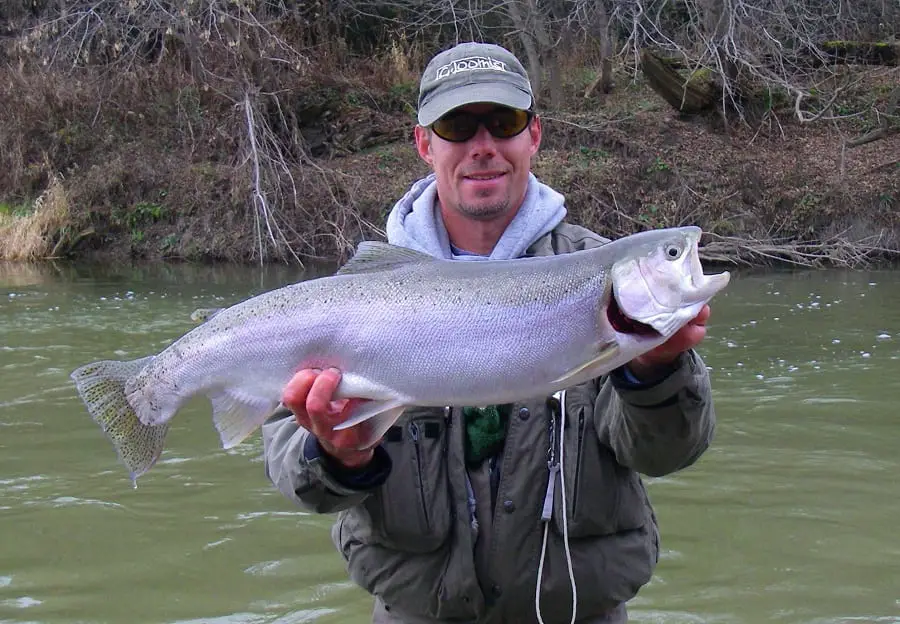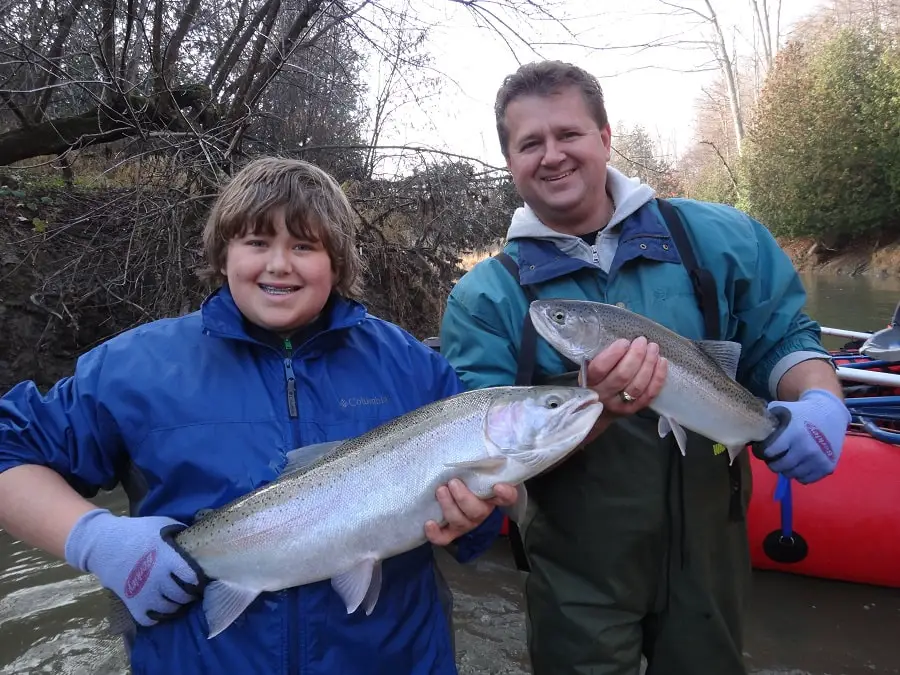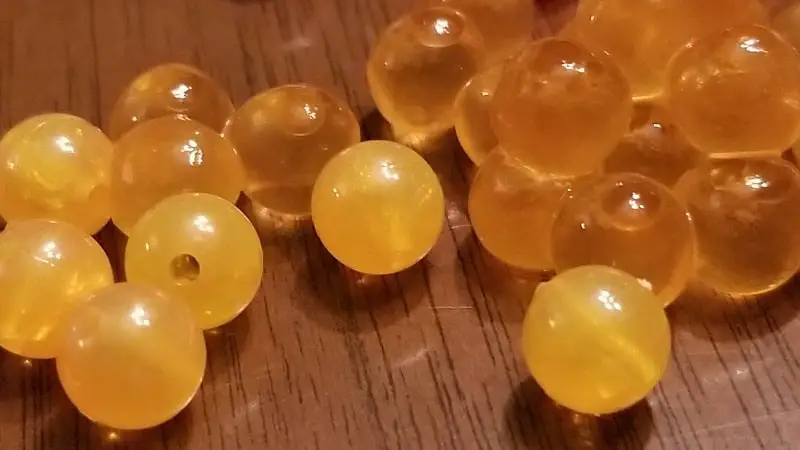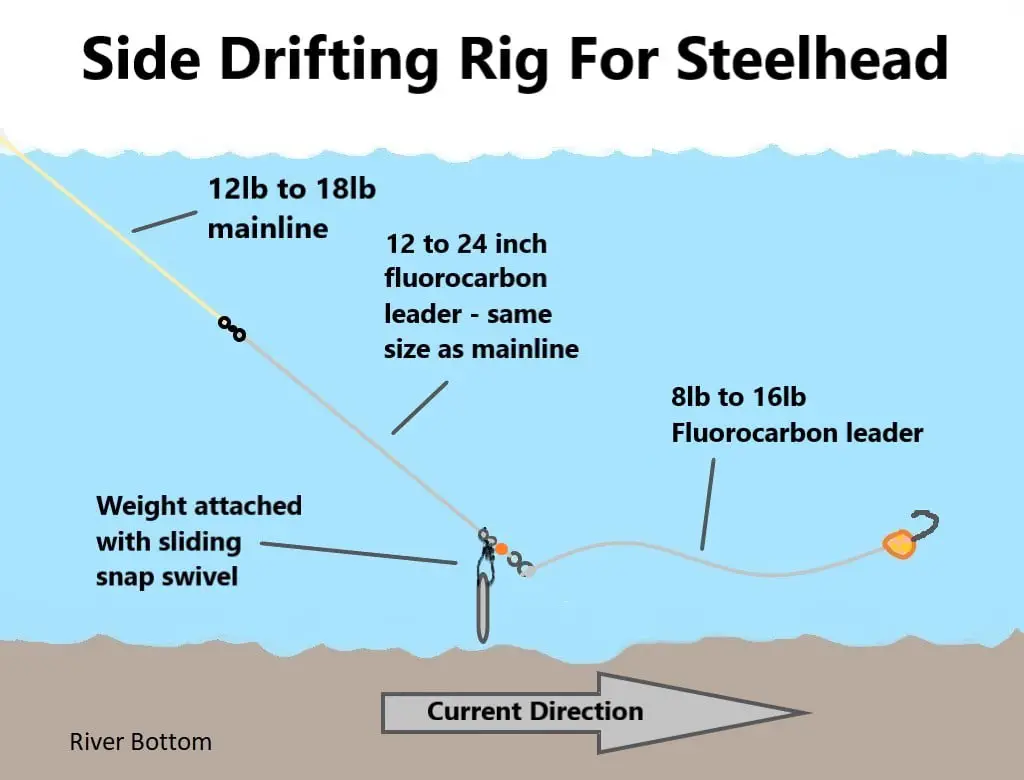Side Drifting For Steelhead: Complete Guide and Setups

Side drifting for steelhead is a fantastic method for fishing from a boat with one or more anglers. It allows you to drift along with the river’s current while presenting your bait effectively from the side of the boat for extra-long drifts that cover lots of water.
In this comprehensive guide, we’ll break down everything you need to know about side drifting for steelhead, especially if you’re relatively new to this exciting technique.
Why Side Drifting for Steelhead?
One of the significant advantages of side drifting is its ability to cover a wide stretch of water. Whether you’re a beginner or an intermediate angler, this method provides an excellent opportunity to target steelhead effectively and cover a lot of river.
Side drifting for salmon is also very effective and popular.
Keys to Successful Side Drifting for Steelhead

To master side drifting for steelhead, there are four critical aspects you should focus on:
- Boat Control: Properly controlling your boat’s drift is essential. You want to match the river’s speed while staying on course.
- The Drift Rig Setup: Your rig setup plays a pivotal role in attracting steelhead. Make sure it’s well-constructed and suitable for the task – see my setup below.
- Presenting the Drift Rig Properly: The way you present your rig matters. Correct presentation increases your chances of enticing steelhead to bite.
- Detecting the Bite: Recognizing when a steelhead bites is crucial. Learn to differentiate between bites and other movements to increase your hook-up rate.
In addition to these four key aspects, it’s important to use the right gear, select the appropriate bait, and know where to fish. We’ll delve into all these aspects as we progress through this guide.
Essential Gear for Side Drifting from a Boat
To succeed in side drifting for steelhead, you’ll need the following equipment:
The Boat: A boat is essential for side drifting. In smaller, shallower rivers, drift boats, pontoon boats, or inflatable rafts work well. On larger, deeper rivers, consider using a power boat with or without a kicker motor or trolling motor.
Rod Selection: Opt for medium-action fishing rods ranging from 9 to 12 feet. These should have a sensitive rod tip to help you detect strikes. Lightweight rods are ideal, especially when casting at longer distances.
Some excellent options include the G. Loomis GLX Classic Steelhead Drift Spinning Rod, Lamiglas X-11 Steelhead Casting Rod, and the budget-friendly Daiwa Northcoast SS Side Drifting Spinning Rod.
Reel Selection: Spinning or casting gear is suitable. Choose a large line-capacity spinning reel with a strong and smooth drag system. Brands like Pflueger President, Pflueger Supreme, and Shimano Stradic are popular choices.
Many anglers also prefer baitcasting reels for this method. Baitcasting reels are also preferred when back trolling and back bouncing for steelhead.
Line: Select a high-visibility monofilament main line with a strength of 8 to 20 pounds is suitable for most steelhead. In the Great Lakes region, 8 to 12-pound test lines are often best. On the West Coast, a 10 to 20-pound test line is best.
For bigger faster rivers, go with a heavier line. For smaller streams, go with a lighter line. High-visibility lines help prevent line crossings and aid in proper line control.
Leader or Dropper Line: Use a leader or dropper line that is two to four pounds lighter than your mainline. Lighter line leaders are less likely to be noticed by steelhead, and I’m a huge fan of light lines for steelhead.
Terminal Tackle: Your side drift rig should include a 6mm stopper bead, a barrel swivel, and a snap swivel.
Hooks: Choose hooks ranging from size 4/0 to size 8, depending on the bait size. Smaller baits require smaller hooks, while larger baits call for larger hooks.
Weights: Have an assortment of pencil lead weights or slinky weights in various sizes to adjust for depth and current speed. Having just enough weight ensures your bait drifts naturally without getting hung up.
Best Baits

Steelhead will hit any bait used in float fishing, drift fishing, or plunking methods.
Consider using bait such as roe bags, cured salmon skein, beads, pink plastic worms, sand shrimp, yarn balls, flies, minnows, or baitfish.
To keep your bait off the bottom, employ a Roe Rig, which consists of two hooks inline with a floating bead or corky between them and an egg loop to secure the skein.
Brightly colored steelhead eggs, salmon roe bags, and skein in an egg loop are popular and effective choices. In muddy water or off-colored water, go with big and bright baits and chartreuse patterns.
Setting Up Your Side Drifting Rig
Properly rigging your setup is crucial for success. Here’s a step-by-step guide:

Controlling the Boat
Boat control is essential for side drift fishing for steelhead. Focus on these three key aspects:
- Keep the nose downriver: Maintain the boat’s nose facing downriver, ensuring it remains perpendicular to the shore or your target area.
- Stay beside the fish: Position your boat to the side of where you believe steelhead are located or moving through.
- Control your speed: Adjust your boat’s speed to match the weight’s movement along the river bottom. This speed may be slower than the surface current.
When using a trolling motor, it’s easier to keep the nose of the boat upriver to slow the boat and keep it moving straight.
Presentation Techniques
A successful presentation can make all the difference. Follow these steps:
- Choose Productive Water: Position upstream and assess the water conditions before you fish the run to identify where steelhead are likely to be holding or moving and adjust the boat as needed while you go through the run.
- Position the Boat: Keep the boat to the side of where the fish should be holding so you can fish productive water off the side of the boat.
- Cast Out: Cast just far enough out to get your bait within the ideal zone where the steelhead should be holding.
- Get to the Bottom: Your weight should take 2 to 4 seconds to reach the riverbed. Be attentive to the sensation of the weight tapping the bottom.
- Don’t Pull: Keep the rod tip up and maintain slight tension in the line to detect subtle movements, like steelhead bites.
- Detecting the Bite: A steelhead bite may feel like a tug or pull on the line, and winter steelhead bite lightly, so pay attention and set or pull on everything. When you detect this, respond promptly.
- Set the Hook: Upon feeling a steelhead bite, set the hook decisively with an upward and sideways motion.
Understanding Steelhead Bites
The bite can be fairly subtle, so distinguishing between bottom contact and steelhead bites can be challenging for new anglers. Here are some tips to help you detect and land more fish:
- Using a rod with a sensitive tip helps.
- A slow, steady pull often indicates bottom contact.
- A faster or irregular pull is more likely a steelhead bite.
- When the sinker stops bouncing, it’s a bite or snag, so pull to check and see.
- When you feel a bite, set the hook swiftly and firmly. Don’t wait too long to respond.
Handling Snags Like a Pro
Snags can be problematic, but you can manage them effectively with these tips:
- Drop Your Rod: If you realize you’re snagged, drop your rod and point it at the snag. Release tension on the line by opening the bail or free spooling a baitcasting reel. Then, tighten and lift the rod quickly to see if the weight will jiggle free from the snag. If it does not pull free, go to option two quickly.
- Snap the Leader: If the first method doesn’t work, point your rod tip at the snag and tighten the spool until the leader snaps.
Tips for Fighting Fish
When multiple anglers are on board with multiple rods in the water, it’s crucial to use these tips:
- When someone hooks into a fish, all anglers in the boat need to reel in their lines as fast as possible to avoid tangles.
- If a line gets crossed and tangled with a fighting fish, loosen the drag to let the line out easily, then reel in slack as the fish gets close to the boat.
- Other anglers can stay behind the angler fighting the fish or help net the fish or help control the boat.
Pro Tips for Side Drift Fishing
To enhance your side drifting experience, consider these pro tips:
- Pre-tie leaders in advance for efficiency. Pre-tied leaders get you fishing faster if you break off.
- Organize your weights by size to switch quickly based on depth and current speed.
- Have extra pre-rigged rods ready in case of breakage.
- Experiment with different baits and sizes if one isn’t producing results.
- Pay attention to patterns and locations where steelhead are frequently spotted or caught.
The Downsides of Side Drifting
While side drifting is an effective method, it does have limitations. It’s essential to recognize these downsides.
I have been known to find the optimum position and park on the spot and fish it thoroughly while other fishing guides drift by and cover a lot of river.
Doing so has enabled me to catch ten times more fish than the other fishing guides, especially when the steelhead are stacked up in a few select pools, and the other fishing guides make a single pass through each spot.
- Side drifting covers a lot of river, but you only get one pass at each pool or run. This means you might miss potential fish in areas where the fish are stacked up. I’ve drifted through spots and seen twenty steelhead sitting in the tail outs as we drift past.
- Consider spending more time in productive pools or runs instead of drifting by too quickly. I’ve been known to fish from the top to the tail outs, then paddle back to the top if there are a lot more steelhead in the spot.
- In wide rivers where the fish are spread out, you are only covering a small area when you drift past once, however, with multiple anglers, they can fish out of both sides of the boat.
Boondogging for Steelhead
Boondogging is a variation of side drifting. Instead of pointing the boat upriver or downriver, you turn the boat sideways, positioning the nose toward the shore.
Anglers then fish from the upriver side of the boat, casting upriver to drag their bait rigs downstream. While Boondogging can be effective in deep water, side drifting is generally preferred by most anglers, especially in clear, shallow conditions where the boat could spook the fish.
Best Water for Side Drifting
Steelhead tend to favor certain types of water, and this method can be fished in any water:
- Slower, deeper water is often a good choice, as steelhead may slow down and rest in these areas, making them more receptive to bait.
- Steelhead generally move quickly through shallow water, making it less ideal for side drifting.
- Look for large rocks in the middle of the river, as they often create sweet spots. Drifting your pencil lead weight alongside or behind these rocks can attract steelhead.
- Identify travel routes in the river, which are typically deeper areas with strong currents. Bubble lines and seams between faster and slower water are also worth exploring.
- Water flow and water clarity make a difference in where the steelhead will hold. They don’t always like very fast water, so fish slower lines beside the fast water. When the water is muddy and fast, steelhead will push closer to the bank
Side Drifting With Flatfish
An alternative and effective approach is to use an F7 Flatfish plug or a similarly sized Kwikfish plug instead of a bait. As the boat moves downstream, cast the rig out, let the weight hit the bottom, and start dragging, which is when the plug will spin and start wobbling.
The plug’s wobbling action can entice steelhead strikes, but ensure you keep the boat moving at the same speed as the weight is drifting. I prefer to keep the boat slightly slower than the current.
A little line bow is okay, but keep slack out of the line, and keep the rod tip up. This method is particularly useful in areas with heavy fishing pressure from bait fishermen.
Drift Fishing With A Bobber Or Float
You can also practice side drifting with a drift bobber or a float. Use the standard float fishing technique, selecting an appropriate float or drift bobber and adding enough weight to match the depth and current speed. For deeper waters, opt for a slip float and more weight. Proper float size ensures it doesn’t sink under the weight.
Side Drifting for Steelhead Q&A
If you have questions, comments, or advice on side drifting for steelhead, feel free to share in the comments section below. We’re here to help you improve your steelhead fishing skills.
Tight Lines,
Graham
